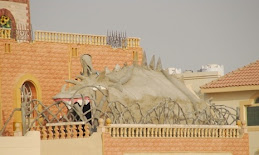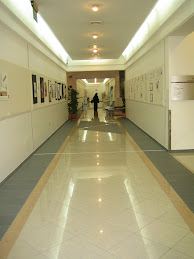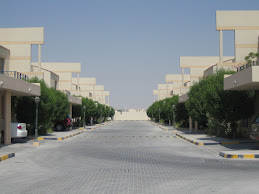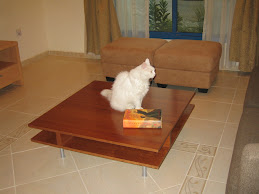Eid is the holiday that marks the end of Ramadan. It seems to vary in length depending on the country and how long they want to close government offices. VCUQ gives students and faculty an entire week off, which they call fall break. Almost as soon as I arrived in Doha, people started asking me where I was going for Eid - it's a popular time to travel here!
So, not wanting to miss an opportunity to travel, I joined a tour group to Jordan that was organized with the help of a travel agent by the Qatar Natural History Group, which is made up of lots of British, Canadian, and American expatriots - "expats" for short. For a day-by-day account of my week in Jordan, illustrated with a few select photos that extend below this Eid posting into the Ramadan posting, read on....
Day 1: at 1:00 AM on Thursday, 12 October we congregated at the Doha airport for our Royal Jordanian flight to Amman, Jordan. Our group of 29 departed at 3:40 AM. Lots of flights from Doha seem to leave in the middle of the night for some reason or another. And did you know that Royal Jordanian serves meals on their flights - even those that only last about 3 hours? Anyway we arrived in Amman about 6:30 AM and were met by a bus and our tour guide, Osama. They took us to downtown Amman via STARBUCKS, which was a welcome sight given our sleep deprived state. We were all impressed immediately with the weather - at least 10 degrees (farenheit) cooler than Doha and less humid. Osama proved to be only an OK tour guide, who loved to laugh - for a long time - at his own jokes. The museum at the Citadel was closed - certainly not Osama's fault, so we walked around a bit and wasted time until we could check into our hotel. We viewed the ancient Roman theatre in the middle of the city, wandered through some shopping streets that were pretty quiet because it was Friday, the Muslim holy day, saw the main mosque, and exchanged money for Jordanian dinars. About noon we checked into our hotel, the Belle Vue, located at Circle 2 in an older part of Amman, then had a late lunch, after which most of us crashed.
Factoid: One of the names the early Romans gave Amman was Philadelphia - I don't think, however, that there was a Pittsburgh was on the other side of the country!
Day 2: Our new tour guide, Nasser, who stayed with us for the next 5 days and whom everyone really liked, met us the next morning at the hotel for excursions to Umm Qays and Jerash, Roman ruins in northern Jordan. The weather was spectacular and from Umm Qays we were able to see the Golan Heights - a very impressive view that emphasized what a special, peaceful country Jordan is in the middle of a very turbulent region. Nasser grew up in the city of Jerash and had wonderful detailed knowledge of the site that is in surprisingly good condition given its age, earth quakes, wars, etc. The bag piper at the theatre was especially memorable. That evening we returned to Amman. My friend, River, the registrar at VCUQ, and her son, Joachin, joined me for a Mexican dinner at the Intercontinental Hotel - they had PORK ribs on their menu, a delicacy for travelers from Qatar, where it's illegal to bring PORK into the country!
Day 3: We again arose early in the morning to travel to the Desert Umayyad Castles (Qasrs) to the east of Amman. It was during one of Narrer's talks about these 8th century castles and forts that he said: "They shared the blood, but sharing the land was harder," a quote that echoed in my mind as I walked through these beautiful examples of early Islamic art and architecture. Our first stop was Qasr Al-Kharana, an archtypal desert fortress. The second site was the bath of Qasr Amra, a UNESCO World Heritage Site with amazing frescoes and mosaics that are especially unique because of their very un-Islamic depictions of people and animals. After that we had lunch then proceeded to the black basalt fort at Azrak, a Roman fort that was later the headquarters of Lawrence of Arabia during the Arab Revolt in the early 20th cenury. For a change of pace we then went to the Azrak Wetlands, habitat for many birds and water buffalo. The wetlands are unfortunately disappearing as the demand for water grows in Jordan's cities.
Another factoid: Jordanian olive oil is considered some of the best in the world and is imported to both Spain and Italy, other major producers of olive oil. Apparently some people in the Middle East drink it, believing it will help them live longer.
Day 4: We checked out of our hotel and headed south to Mount Nebo, the place where Moses was buried. There we saw the Moses Memorial Church, which protects a number of mosaics from a much earlier church that was built on the same site, and we had an incredible view that stretched across the Jordan River Valley, past the Dead Sea to Jerusalem. From there we continued south to Madaba, which is known as the "city of mosaics." There we went to the contemporary Greek Orthodox church of St. George to see a mosaic 6th century Byzantine map of the Holy Land. Madaba is also the home of a mosaic school that operates under the Ministry of Tourism and trains artisans in the making, restoring, and repairing of mosaics. Unfortunately I didn't feel I could afford to purchase a mosaic from one of the shops we went to, but I now have a much better understanding of how they are made. That afternoon we continued south through the Wadi Mujib - Jordan's Grand Canyon - and stopped at Karak Castle. That evening we checked into the Taybet Zaman, a wonderful hotel decorated with Bedouin textiles, near Petra.
Day 5: Petra is wonderful. It is an amazing series of buildings, located at Wadi Musa, that were carved out of solid rose-red rock by the Nabataeans, an Arab civilization that lived there more than 2000 years ago. It was eventually claimed as a part of the Roman Empire, but was forgotten by the West by the beginning of the 14th Century and was only rediscovered in 1812 by a Swiss traveler who was looking for the ancient city of Petra. We rode horses as close as we could and then proceeded on foot to the Siq, the narrow slot in the rock that opens up to the magnificent Treasury Building. Local Bedouins operate the horse, donkey, and camel concessions - the camel ride I took with River and Joachin was outstanding.
Recommended reading: Married to a Bedouin (2006) by Marguerite van Geldermalsen is set in Petra, where she met and married Mohammed Abdallah, a Bedouin. They set up housekeeping in one of Petra's caves and had three children. Marguerite spoke at VCUQ in September. I unfortunately missed her lecture and book signing, but her son, Raamie, was at Petra selling autographed copies of the book, so I bought it there and thoroughly enjoyed reading her account of life in Petra.
Day 6: We sadly left Petra (a place I would happily return to if ever given the opportunity) the next morning and went to Wadi Rum for a bedouin tour of the desert in that area via pickup trucks outfitted for tourists. There we saw the Seven Pillars of Wisdom (a rock formation of 7 columns that I think provided the name for T.E. Lawrence's book), petroglyphs, and sand dunes. After that we headed back to Amman and the Belle Vue Hotel.
Day 7: We packed our bags for the flight home, but made a planned stop at the Dead Sea Spa for a swim and mud baths! That was fun - nearly everyone got into it - especially since Osama, who had rejoined us that morning, promised we'd loose years if we did!
Parting comments: the Hashemite Kingdom of Jordan is wonderful. If you ever get a chance to go there, don't miss it. It definitely rivals Greece for wonderful ancient architecture and has a similar landscape, although the red sand is unique to Jordan. And by all means, go to Petra at least once in your life-time.
Sunday, October 28, 2007
Saturday, October 27, 2007
Ramadan
As a Christian westerner I knew very little about Ramadan when it began on September 12th. I am far from an expert on Ramadan, but will share my experiences here.
First a basic, abbreviated description of Ramadan: it lasts for one lunar month (28 days), so its occurance varies yearly on the calendar. For Ramadan, Muslims fast during daylight hours - they go the entire day without any food or drink, not even water. After the evening prayer that coincides with sundown they break their fast with a meal that is called Iftar. Traditionally, the first foods they will eat are dates and water.
Although this description is simple, it has a huge impact on daily life in Islamic countries. For example, our classes at VCUQ were rescheduled by cutting 20 minutes off each class period and advancing all of the classes through the day to a new start time; one result was that my senior studio that usually ends at 6:00 PM ended instead at 4:40 PM. This was done so the students would be able to get home to break fast with their families, but also because they are very tired by the end of the day.
Most restaurants are closed during Ramadan daylight hours; the only exceptions in Doha that I was aware of (although I'm sure there were many others) were hotel restaurants and the cafeteria at Education City in the LAS building. And many businesses - even exercise classes - have modified hours. For example, the shops at Villagio, the shopping center closest to me, were open for a few hours in the morning, then closed and re-opened after sundown until past midnight. The Doha syndicate, where liquor is purchased, was closed the entire month. And just like Christmas in the USA, there are special decorations in most stores. Common greetings are Ramadan Kareem or Ramadan Mubarak (which translate as "Ramadan Blessings").
In orientation sessions at the beginning of the semester, new faculty were cautioned not to eat or drink in front of students during the day. As a lifetime Weight Watcher, who is seldom without a bottle of water, I had to really be careful about this - and in fact forgot the first day of Ramadan, but was kindly reminded by another faculty member to ditch my water bottle. Driving in Doha is often a bit scary, but during Ramadan it can be especially harrowing, so we were cautioned to stay off the roads just before sundown because many hungry Muslims would be headed to their family homes for Iftar. I actually found that advice to be untrue, but I did observe that traffic jams were more frequent during Ramadan, and, as soon as the evening call to prayer was heard, the streets were empty.
Many Qatari families gather for Iftar every night - children, grandchildren, aunts and uncles. For some, this is a time for lavish entertaining and parties that go into the wee hours of morning...and this will happen night after night. My students in families like that were wiped out during classes. Some fell asleep during class, few worked outside of class (as is expected in a design curriculum), and absences and excuses were rampant. And their performance dropped significantly, particularly during the last 10 days of Ramadan when additional prayers are to be said throughout the night.
Other families will have a large meal with their extended family for Iftar and another smaller meal in their own home just before they go to sleep around midnight. Then they will try to wake up a bit before daybreak for a light snack. My students, whose families approached Ramadan in this more moderate manner, tended to be more alert in class and got their work done. My office mate, Maryam, who graduated in the program several years ago and is now the department assistant, told me that she becomes so used not to eating during the day that she goes through a period after Ramadan when she has to become accustomed to having food during the day again.
This is also a time for special charity drives. Someone told me that good deeds performed during Ramadan are supposed to count double, but I don't know if that is true or not. It is also a time for travel. One of my students made a pilgrimage to Mecca with her father and brought back dates from Medina, and others traveled to see family (thus some of the absences in my classes). Several of my students who had not worn abayas before, started wearing them during Ramadan, and the English radio station I listen to devoted a considerable amount of time to special discussions about Ramadan and fasting. One discussion about whether you could brush your teeth or not during Ramadan (you cannot) stuck in my mind because of the serious tone of the speaker.
Some people are excused from fasting - e.g., pregnant women and those having their period, but they have to make it up later. I heard one student who was very concerned about this because she was caught in an uncomfortable situation: she was allowed to eat, but she couldn't do it because she didn't want anyone to know she was having her period. One woman told me that she preferred to fast while she was pregnant, because she didn't want to go through it alone later...I can only imagine what fasting Muslims in non-Islamic countries must go though to observe Ramadan - it's got to be tough for them.
First a basic, abbreviated description of Ramadan: it lasts for one lunar month (28 days), so its occurance varies yearly on the calendar. For Ramadan, Muslims fast during daylight hours - they go the entire day without any food or drink, not even water. After the evening prayer that coincides with sundown they break their fast with a meal that is called Iftar. Traditionally, the first foods they will eat are dates and water.
Although this description is simple, it has a huge impact on daily life in Islamic countries. For example, our classes at VCUQ were rescheduled by cutting 20 minutes off each class period and advancing all of the classes through the day to a new start time; one result was that my senior studio that usually ends at 6:00 PM ended instead at 4:40 PM. This was done so the students would be able to get home to break fast with their families, but also because they are very tired by the end of the day.
Most restaurants are closed during Ramadan daylight hours; the only exceptions in Doha that I was aware of (although I'm sure there were many others) were hotel restaurants and the cafeteria at Education City in the LAS building. And many businesses - even exercise classes - have modified hours. For example, the shops at Villagio, the shopping center closest to me, were open for a few hours in the morning, then closed and re-opened after sundown until past midnight. The Doha syndicate, where liquor is purchased, was closed the entire month. And just like Christmas in the USA, there are special decorations in most stores. Common greetings are Ramadan Kareem or Ramadan Mubarak (which translate as "Ramadan Blessings").
In orientation sessions at the beginning of the semester, new faculty were cautioned not to eat or drink in front of students during the day. As a lifetime Weight Watcher, who is seldom without a bottle of water, I had to really be careful about this - and in fact forgot the first day of Ramadan, but was kindly reminded by another faculty member to ditch my water bottle. Driving in Doha is often a bit scary, but during Ramadan it can be especially harrowing, so we were cautioned to stay off the roads just before sundown because many hungry Muslims would be headed to their family homes for Iftar. I actually found that advice to be untrue, but I did observe that traffic jams were more frequent during Ramadan, and, as soon as the evening call to prayer was heard, the streets were empty.
Many Qatari families gather for Iftar every night - children, grandchildren, aunts and uncles. For some, this is a time for lavish entertaining and parties that go into the wee hours of morning...and this will happen night after night. My students in families like that were wiped out during classes. Some fell asleep during class, few worked outside of class (as is expected in a design curriculum), and absences and excuses were rampant. And their performance dropped significantly, particularly during the last 10 days of Ramadan when additional prayers are to be said throughout the night.
Other families will have a large meal with their extended family for Iftar and another smaller meal in their own home just before they go to sleep around midnight. Then they will try to wake up a bit before daybreak for a light snack. My students, whose families approached Ramadan in this more moderate manner, tended to be more alert in class and got their work done. My office mate, Maryam, who graduated in the program several years ago and is now the department assistant, told me that she becomes so used not to eating during the day that she goes through a period after Ramadan when she has to become accustomed to having food during the day again.
This is also a time for special charity drives. Someone told me that good deeds performed during Ramadan are supposed to count double, but I don't know if that is true or not. It is also a time for travel. One of my students made a pilgrimage to Mecca with her father and brought back dates from Medina, and others traveled to see family (thus some of the absences in my classes). Several of my students who had not worn abayas before, started wearing them during Ramadan, and the English radio station I listen to devoted a considerable amount of time to special discussions about Ramadan and fasting. One discussion about whether you could brush your teeth or not during Ramadan (you cannot) stuck in my mind because of the serious tone of the speaker.
Some people are excused from fasting - e.g., pregnant women and those having their period, but they have to make it up later. I heard one student who was very concerned about this because she was caught in an uncomfortable situation: she was allowed to eat, but she couldn't do it because she didn't want anyone to know she was having her period. One woman told me that she preferred to fast while she was pregnant, because she didn't want to go through it alone later...I can only imagine what fasting Muslims in non-Islamic countries must go though to observe Ramadan - it's got to be tough for them.
Friday, October 5, 2007
Architecture in Doha
There is building going on everywhere in Doha - skyscrapers along the bay for offices and housing, 2-3 story residential compounds (walled multi-family villas), private compounds (also enclosed by walls, but here the walls have a dual function: keeping out the rif-raff and women need not wear the abaya, shayla, and niqab when within the walls of their compound), shopping malls, government buildings, etc. As a result there are also construction vehicles (cement trucks, etc) everywhere and lots of road construction - I'll talk more about driving in Doha in a later posting.
You've already seen pictures of my villa and compound and the VCUQ building where I teach. Those are some of the more modest building types in Doha. The VCUQ building, for example, contains many design elements that are characteristic of traditional architecture in this area. The skyscrapers however belong to another genre with each trying to top the last design-wise. For example, there are tall twin zig-zag buildings and a tower that twists is under construction. Monumental often seems to be the objective as well as designing a building that no one else has ever built. There is also an ongoing challenge to traditional structural engineering. And, of course, the architects love it - they are receiving once-in-a-lifetime commissions to create the building that will seal their place in architectural history.
As examples of this monumental trend in architecture, I am posting a rendering of the proposed National Library of Doha and some new buildings that Rem Koolhaas has designed for the Qatar Foundation at Education City, where VCUQ is. I'll also post a much more traditional example of architecture - and, in my opinion, one of the more compelling sites in Doha: the Islamic Center, as well as a good example of a follie: the Dinosaur Majilis! And later, when I get a chance, I'll take pictures of the Isozaki's building at Education City, I.M. Pei's museum that is topped by eyes looking through a niqab (kind of eerie), and others.
You've already seen pictures of my villa and compound and the VCUQ building where I teach. Those are some of the more modest building types in Doha. The VCUQ building, for example, contains many design elements that are characteristic of traditional architecture in this area. The skyscrapers however belong to another genre with each trying to top the last design-wise. For example, there are tall twin zig-zag buildings and a tower that twists is under construction. Monumental often seems to be the objective as well as designing a building that no one else has ever built. There is also an ongoing challenge to traditional structural engineering. And, of course, the architects love it - they are receiving once-in-a-lifetime commissions to create the building that will seal their place in architectural history.
As examples of this monumental trend in architecture, I am posting a rendering of the proposed National Library of Doha and some new buildings that Rem Koolhaas has designed for the Qatar Foundation at Education City, where VCUQ is. I'll also post a much more traditional example of architecture - and, in my opinion, one of the more compelling sites in Doha: the Islamic Center, as well as a good example of a follie: the Dinosaur Majilis! And later, when I get a chance, I'll take pictures of the Isozaki's building at Education City, I.M. Pei's museum that is topped by eyes looking through a niqab (kind of eerie), and others.
Subscribe to:
Comments (Atom)













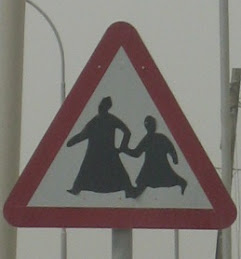



.jpg)


